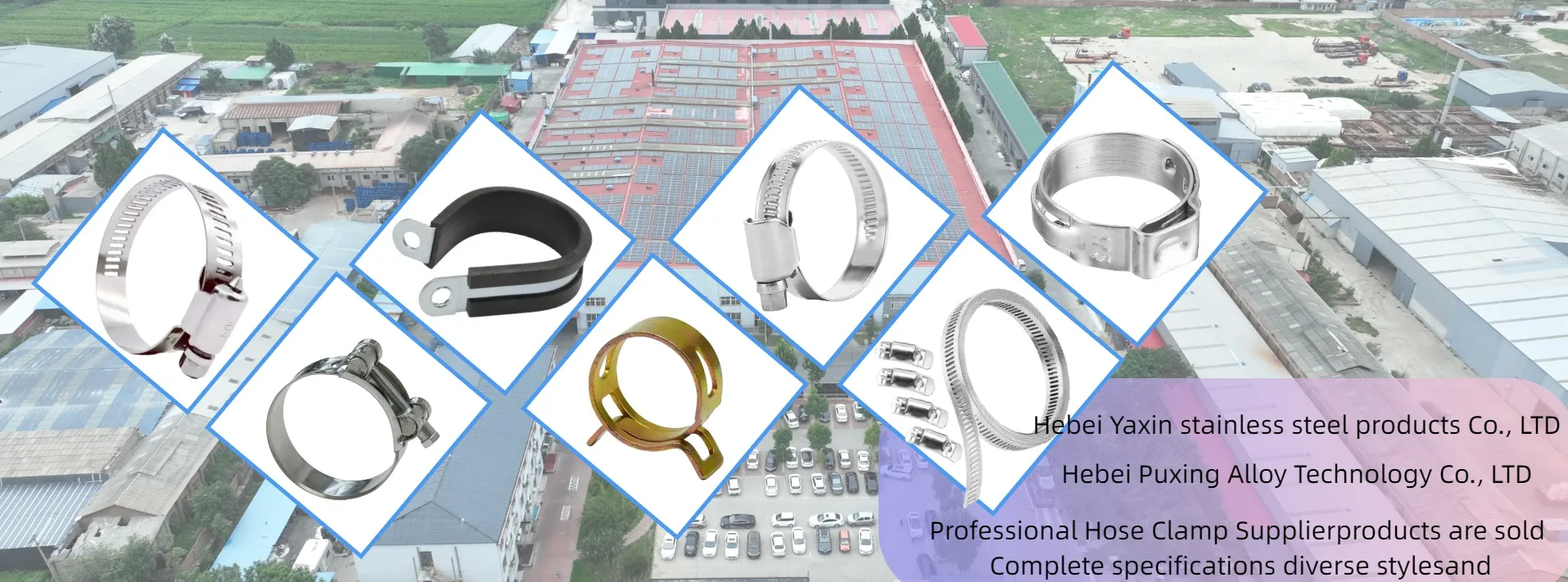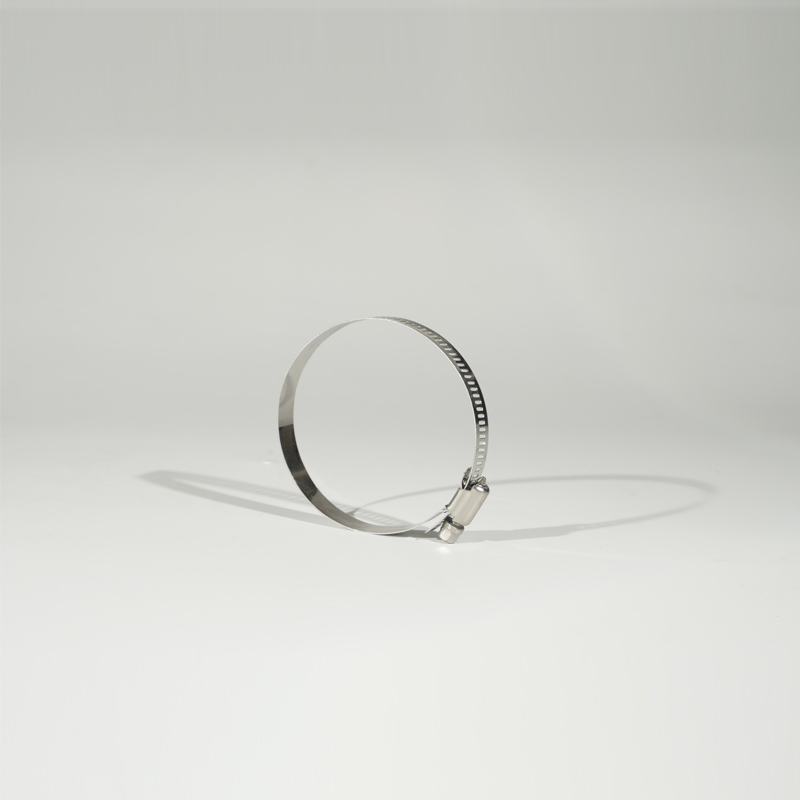- Phone:+86-17331948172 +86-0319-8862898
- E-mail: inquiry@puxingclamp.com
আগস্ট . 08, 2025 02:20 Back to list
Premium Stainless Steel Hose Clip | Secure & Rust-Proof Clamps
In the intricate tapestry of industrial and domestic fluid transfer systems, the seemingly small component of a stainless steel hose clip plays an outsized role in ensuring reliability, safety, and longevity. Far more than just a fastener, these precision-engineered devices are the linchpin holding countless connections secure under demanding conditions. From automotive engines to complex petrochemical plants, the integrity of a hose connection often hinges on the quality and performance of its clamp. This comprehensive guide delves into the world of stainless steel hose clips, exploring their critical role, technical intricacies, diverse applications, and the factors that define excellence in their manufacturing.
Industry Trends: The Evolving Landscape of Fluid Connection
The global market for fasteners, including specialty clamps like the stainless steel hose clamp, is experiencing steady growth, driven by increasing industrialization, infrastructure development, and the burgeoning demand for robust, corrosion-resistant solutions across sectors. According to recent market reports, the global industrial fasteners market is projected to reach over $110 billion by 2027, with a significant segment dedicated to high-performance clamping solutions. The rising awareness regarding leak prevention, safety regulations (e.g., in oil & gas, medical, and food processing), and the need for durable materials in harsh environments are propelling the adoption of premium materials like stainless steel. Furthermore, the push for lighter, more efficient, and maintenance-free systems translates directly into a higher demand for advanced clamping technologies. Innovations in design, such as quick-release mechanisms and optimized torque application, are also shaping the market, ensuring that modern hose clamps offer not just secure fastening but also ease of installation and reduced downtime.
The trend towards specialized applications, where standard solutions fall short, also drives the market for customized stainless steel hose clamps. Industries are increasingly seeking clamps that can withstand extreme temperatures, aggressive chemicals, or high vibration, necessitating materials like Stainless Steel 304, 316, or even duplex stainless steels for superior performance. This evolution underscores the importance of a reliable stainless steel hose clip as a fundamental component in critical fluid handling systems.
Technical Parameters & Specifications of Stainless Steel Hose Clips
Understanding the technical parameters of a stainless steel hose clip is paramount for selecting the right product for a specific application. The performance of a clamp is determined by its material composition, design, and manufacturing precision. Our product, the Stainless steel 304 hose clamps, exemplifies a commitment to these critical specifications.
Key Parameters:
- Material Grade: Primarily Stainless Steel 304 (UNS S30400), offering excellent corrosion resistance to most oxidizing acids and good resistance to general corrosion. For more aggressive environments, Stainless Steel 316 (UNS S31600) is often specified due to its added molybdenum content, which enhances resistance to pitting and crevice corrosion, particularly in chloride-rich environments.
- Band Width: Common widths include 8mm, 9mm, 12.7mm (1/2 inch), 14.2mm, and 16mm. A wider band generally distributes clamping force more evenly and offers greater holding power.
- Thickness: Typically ranges from 0.6mm to 1.0mm. Thicker bands provide higher tensile strength and torque resistance.
- Clamping Range: The effective diameter range the clamp can secure. This is crucial for matching the clamp to the hose size. For instance, a 2 inch hose clamp (approximately 50mm) would have a specific clamping range, while a 12 inch hose clamp (approximately 300mm) would have a much larger one.
- Torque Specifications: The recommended tightening torque (e.g., 4-6 Nm for a standard worm drive clamp) ensures optimal sealing without over-tightening, which can damage the hose or the clamp.
- Screw Type: Often a slotted head, Phillips head, or hexagonal head for various installation tools. High-quality clamps use stainless steel screws to prevent galvanic corrosion with the band.
- Housing Type: Stamped or welded. Stamped housings are more common for general use, while welded housings offer superior strength and are preferred for heavy-duty applications.
- Salt Spray Test Resistance: A standard measure of corrosion resistance, often measured in hours (e.g., 72 hours, 144 hours, or 200 hours without red rust). This is critical for outdoor or marine applications.
Below is a comparative table summarizing typical parameters for common stainless steel hose clamp types:
| Parameter | Worm Drive (Standard) | Heavy Duty (T-Bolt) | Spring Clamp | Band Roll Clamp |
|---|---|---|---|---|
| Material Grades | SS304, SS301 | SS304, SS316 | Spring Steel, SS | SS304, SS316 |
| Band Width | 8mm, 12.7mm (1/2") | 19mm, 25mm (3/4", 1") | Variable | 12.7mm, 14.2mm |
| Band Thickness | 0.6 - 0.8 mm | 0.8 - 1.2 mm | N/A | 0.6 - 1.0 mm |
| Clamping Mechanism | Worm gear screw | T-bolt and nut | Spring tension | Perforated band & buckle |
| Typical Torque (Nm) | 4-6 | 10-20+ | N/A (pre-tensioned) | 8-15 |
| Application | General purpose, automotive, plumbing | High pressure, heavy vibration, industrial | Thermal expansion/contraction | Custom large diameters, emergency repair |
| Corrosion Resistance | Good (SS304) | Excellent (SS304/SS316) | Moderate to Good | Excellent (SS304/SS316) |
| Reusable | Yes | Yes | Yes (limited) | Yes (with new band) |
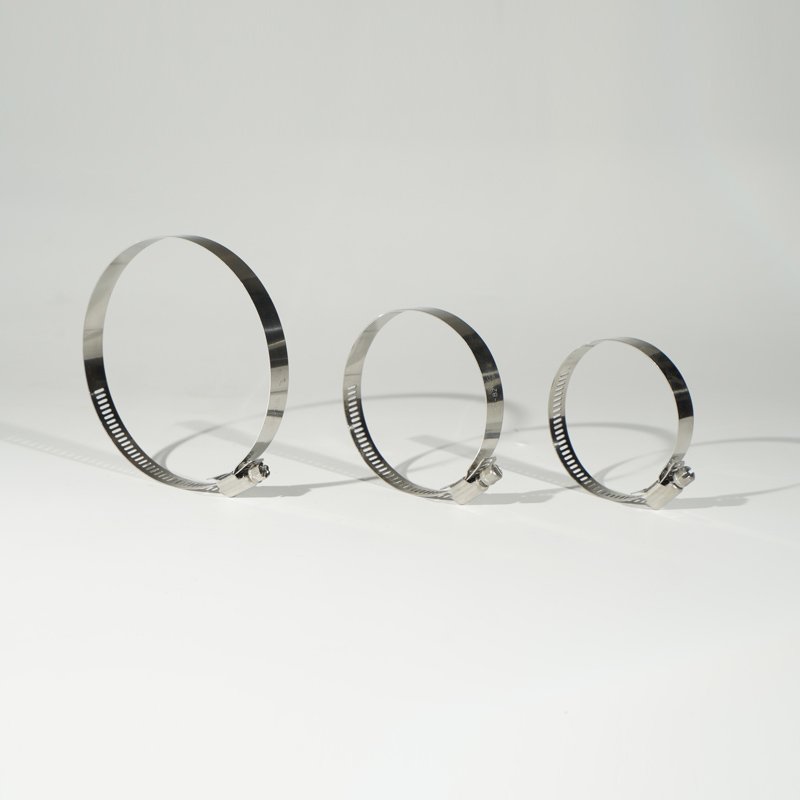
Application Scenarios: Where Stainless Steel Hose Clips Excel
The versatility and robust nature of the stainless steel hose clamp make it indispensable across a multitude of industries. Its inherent resistance to corrosion, high temperatures, and mechanical stress ensures reliable performance in the most demanding environments. Here are some key application areas:
- Automotive Industry: From radiator hoses and fuel lines to exhaust systems, stainless steel hose clamps secure critical connections, resisting engine vibrations, temperature fluctuations, and exposure to corrosive fluids like coolants and oils.
- Marine Applications: Essential for boats and ships, these clamps withstand saltwater corrosion, a severe challenge for other materials, ensuring the integrity of bilge pumps, cooling systems, and exhaust hoses.
- Plumbing and HVAC: Used extensively in residential, commercial, and industrial plumbing systems for securing water lines, drainage pipes, and ventilation ducts. Their durability prevents leaks and ensures long-term system integrity.
- Petrochemical & Chemical Processing: In environments exposed to aggressive chemicals and high temperatures, the superior corrosion resistance of Stainless Steel 304 and 316 makes them ideal for securing hoses transporting various fluids, gases, and slurries.
- Food & Beverage Processing: Stainless steel is the material of choice due to its hygienic properties and ease of cleaning, preventing contamination. Hose clamps in this sector must meet strict sanitation standards.
- Agriculture: Used on irrigation systems, farm machinery, and processing equipment, providing reliable connections in outdoor and often muddy/wet conditions.
- Mining and Construction: For heavy machinery hydraulics, water pumps, and ventilation systems, where robust, vibration-resistant connections are crucial.
- Medical and Pharmaceutical: In controlled environments, stainless steel clamps are used for tubing and hose connections due to their sterile properties and resistance to cleaning agents.
The adaptability of the stainless steel hose clip is evident in its ability to perform reliably across such diverse and critical sectors, proving its worth as a high-performance fastening solution.
Technical Advantages: Why Stainless Steel is the Superior Choice
Choosing a stainless steel hose clip, particularly one made from Stainless Steel 304 like our Stainless steel 304 hose clamps, offers a host of technical advantages over other materials. These advantages directly translate into enhanced system performance, reduced maintenance, and improved safety.
Unmatched Corrosion Resistance:
Stainless steel forms a passive chromium oxide layer on its surface, which self-retains when scratched, providing exceptional resistance to rust and various corrosive agents. This is paramount in moist, saline, acidic, or alkaline environments. Unlike carbon steel clamps which quickly succumb to corrosion, leading to joint failure, a stainless steel hose clamp maintains its structural integrity and aesthetic appearance for years. This is particularly crucial in marine, outdoor, and chemical processing applications, where constant exposure to harsh elements would rapidly degrade lesser materials.
Superior Strength and Durability:
Stainless steel boasts high tensile strength and ductility, allowing clamps to withstand significant pressure and vibration without deforming or breaking. This ensures a consistent, tight seal over time, even under dynamic loads. The robustness of a stainless steel hose clamp contributes directly to a longer service life for the entire hose assembly, reducing the frequency of replacements and associated downtime. Many of our clamps are designed to exceed industry standards like SAE J1508, ensuring they meet rigorous performance criteria.
Temperature Resistance:
Stainless steel retains its mechanical properties across a wide range of temperatures, from cryogenic lows to elevated industrial process temperatures. This makes it suitable for applications where thermal cycling occurs, such as in automotive engines or industrial heat exchangers, preventing material fatigue and ensuring the clamp remains effective regardless of temperature fluctuations.
Hygienic Properties:
For industries like food and beverage, pharmaceuticals, and medical devices, the non-porous surface of stainless steel resists bacterial growth and is easy to sterilize. This makes stainless steel hose clamps an ideal choice where cleanliness and preventing contamination are paramount, complying with standards like FDA regulations for material contact.
Aesthetic Appeal & Environmental Impact:
The polished finish of stainless steel offers a clean, professional appearance. Furthermore, stainless steel is 100% recyclable, contributing to sustainable manufacturing practices and reducing environmental footprint.
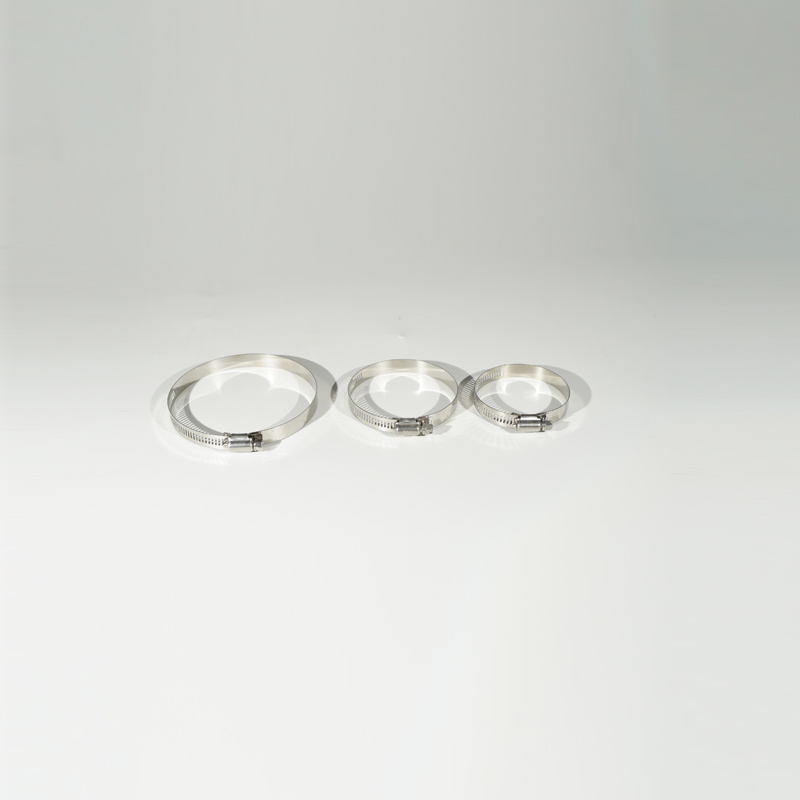
Manufacturing Process: Crafting the Stainless Steel Hose Clip
The production of a high-quality stainless steel hose clip involves a series of precision manufacturing steps, each critical to the final product's performance and reliability. While specific methods may vary slightly between types (e.g., worm drive vs. T-bolt), the general principles ensure strength, durability, and a consistent fit. Puxing Clamp's Stainless steel 304 hose clamps undergo a rigorous process designed for optimal quality.
Detailed Process Flow:
- Material Sourcing & Preparation:
The journey begins with sourcing high-grade stainless steel coils, typically AISI 304 or 316. Material certifications (e.g., ASTM A240 for stainless steel sheet, plate, and strip) are crucial here to ensure chemical composition and mechanical properties meet specifications. The coils are unrolled and cut into strips of the required width for the band and housing components.
- Stamping & Forming (Band & Housing):
High-precision progressive dies are used in hydraulic or mechanical presses to stamp out the intricate shapes of the clamp band, housing, and bridge (if applicable). For worm-drive clamps, the band is perforated with slots, and the housing is formed to accommodate the worm screw. This step requires exceptional tooling accuracy to ensure precise dimensions and smooth edges, preventing hose damage.
- Screw & Bridge Fabrication:
The worm screws are typically cold-formed from stainless steel wire, then roll-threaded to ensure high strength and smooth operation. For clamps with a separate bridge, this component is also stamped and formed.
- Assembly:
Automated or semi-automated assembly lines bring the components together. The band is fed through the housing, and the screw is inserted. For some heavy-duty clamps, components like the housing and bridge might be resistance-welded to the band for superior strength, though stamping and interlocking mechanisms are more common for standard worm drive clamps. Robotic arms ensure consistency and speed in this phase.
- Finishing & Polishing:
After assembly, clamps may undergo deburring processes to remove any sharp edges. Some clamps might be polished or passivated to enhance corrosion resistance and aesthetic appeal. Passivation is a chemical process that removes free iron from the surface of stainless steel, forming a uniform, protective chromium oxide layer.
- Quality Control & Testing:
Each batch undergoes rigorous quality checks. This includes:
- Dimensional Inspection: Using calipers and gauges to verify band width, thickness, and clamping diameter range.
- Material Verification: X-ray Fluorescence (XRF) or spectrographic analysis to confirm stainless steel grade (e.g., SS304).
- Torque Testing: Applying specified torque to ensure the clamp holds securely without stripping the screw or damaging the band.
- Tensile Strength Test: Measuring the force required to break the clamp.
- Salt Spray Testing (ASTM B117): Exposing clamps to a saline mist to assess their corrosion resistance over time, typically for 72 hours, 144 hours, or even 200+ hours. Our products consistently exceed standard requirements.
- Visual Inspection: Checking for burrs, sharp edges, or manufacturing defects.
Adherence to international standards such as ISO 9001 for quality management and specific product performance standards (e.g., SAE J1508 for worm-drive clamps) is maintained throughout the process, ensuring every stainless steel hose clamp meets stringent requirements.
- Packaging & Dispatch:
Finally, the clamps are counted, packaged, and prepared for shipment to clients worldwide.
(In a real-world scenario, a link to a short manufacturing video or an interactive infographic would be placed here to visually demonstrate the process.)
Manufacturer Comparison & Choosing Your Partner
Selecting the right manufacturer for your stainless steel hose clip needs is as crucial as understanding the product itself. The market is populated by numerous suppliers, but not all offer the same level of quality, expertise, or service. When evaluating potential partners, consider the following:
Key Factors for Comparison:
- Certifications & Standards: A reputable manufacturer will possess certifications like ISO 9001 (Quality Management System), ISO 14001 (Environmental Management), and adhere to relevant product standards (e.g., SAE J1508 for hose clamps, ASTM for material specifications). These indicate a commitment to consistent quality and ethical practices.
- Experience & Specialization: Look for manufacturers with a long history in the industry and a proven track record specifically in stainless steel fastening solutions. Specialization often means deeper technical knowledge and more refined manufacturing processes. Puxing Clamp, with over 15 years of experience, specializes in high-quality clamping solutions.
- Material Traceability: Can the manufacturer provide verifiable material certificates (MTCs) for the stainless steel used? This ensures you are indeed getting the specified grade (e.g., SS304) and not an inferior alloy.
- Quality Control Protocols: Inquire about their QC processes – from raw material inspection to final product testing (dimensional, torque, salt spray, fatigue tests). Robust QC minimizes defects and ensures performance.
- Customization Capabilities: Do they offer bespoke solutions for unique applications, or are they limited to standard sizes? The ability to provide custom 2 inch hose clamp or even larger 12 inch hose clamp sizes, or specific material compositions, can be a significant advantage.
- Customer Support & After-Sales Service: Responsive communication, technical support, and clear warranty policies are indicators of a reliable partner.
- Pricing vs. Value: While price is a factor, focus on the overall value. A cheaper clamp might lead to higher long-term costs due to failures, leaks, and replacements. Invest in quality for critical applications.
Puxing Clamp's Commitment: At Puxing Clamp, we pride ourselves on being a leading manufacturer of premium stainless steel hose clamps. Our Stainless steel 304 hose clamps are a testament to our dedication to quality, precision engineering, and customer satisfaction. We maintain strict adherence to ISO 9001 standards, utilize advanced manufacturing technologies, and conduct rigorous multi-stage quality checks, including advanced salt spray testing and torque testing, to ensure superior product performance and longevity. Our long-standing partnerships with industry leaders and our strong track record speak to our authority and trustworthiness in the field.
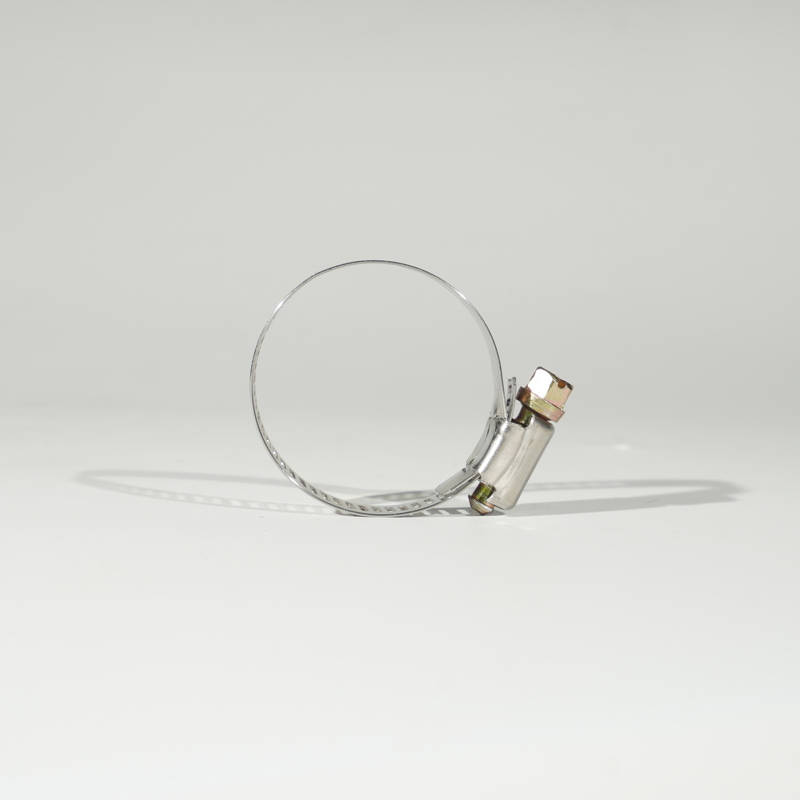
Customization Solutions & Tailored Performance
While standard stainless steel hose clamps cater to a broad range of needs, many specialized industrial applications require custom solutions. The ability to tailor design, material, and finish can significantly enhance performance, reliability, and cost-efficiency in specific scenarios. Our expertise extends to providing comprehensive customization options for stainless steel hose clips, ensuring a perfect fit for even the most unique requirements.
Examples of Customization:
- Specific Material Grades: Beyond SS304 and SS316, we can provide clamps in specialized alloys for extreme chemical resistance, higher temperatures, or specific mechanical properties.
- Unique Dimensions: Custom band widths, thicknesses, or specific clamping diameter ranges for non-standard hoses or pipes (e.g., a specific 2 inch hose clamp variant for a unique medical device or a large diameter 12 inch hose clamp for heavy industrial ducting).
- Custom Locking Mechanisms: Development of specific screw heads (e.g., tamper-proof, quick-release), or alternative locking systems like over-center latches for quick access applications.
- Integrated Components: Clamps designed to integrate sensors, specific mounting brackets, or unique sealing elements.
- Surface Treatments: Passivation for enhanced corrosion resistance, electropolishing for ultra-hygienic applications, or specific coatings for color-coding or friction reduction.
- Branding & Packaging: Custom laser engraving, specific packaging for retail or industrial bulk, and private labeling.
Our engineering team works closely with clients from conceptualization to prototyping and final production, leveraging advanced CAD/CAM tools and simulation software to design and validate custom stainless steel hose clamp solutions. This collaborative approach ensures that the tailored product not only meets but often exceeds the functional demands of the application, delivering optimized performance and long-term value.
Application Cases & Success Stories
The real measure of a product's effectiveness lies in its performance in real-world scenarios. Our Stainless steel 304 hose clamps have been instrumental in numerous critical applications, delivering superior performance and customer satisfaction. Here are a few illustrative cases:
Case Study 1: High-Pressure Hydraulic System in Heavy Machinery
A leading manufacturer of construction excavators required extremely durable hose clamps for their hydraulic lines, which operate under intense pressure and constant vibration. Standard carbon steel clamps frequently failed, leading to costly leaks and downtime. We provided heavy-duty stainless steel hose clamps (T-bolt type, SS316 material) with increased band thickness and precise torque specifications. After implementing our clamps, the client reported a 90% reduction in hydraulic line failures over a 24-month period, significantly improving operational efficiency and reducing maintenance costs. The superior fatigue resistance and vibration damping of the stainless steel clamp proved invaluable.
Case Study 2: Corrosive Environment in Coastal Water Treatment Plant
A municipal water treatment facility located near the coast faced severe corrosion issues with their water supply and chemical dosing lines. Traditional galvanized clamps rusted rapidly, compromising pipe integrity and requiring frequent replacement. We supplied custom-sized stainless steel hose clamps made from SS304, specifically designed for a highly humid, saline environment. The project manager noted a dramatic improvement in the lifespan of the connections, with no signs of red rust or degradation after three years of continuous exposure. This demonstrated the exceptional anti-corrosion properties and long service life of our stainless steel hose clip in extreme conditions, leading to substantial savings on maintenance and replacement parts.
Case Study 3: Food Processing Facility Sanitation Compliance
A large-scale dairy processing plant needed hose clamps that met stringent hygiene and sanitation standards for their milk transfer lines. Any material that could harbor bacteria or degrade under harsh cleaning chemicals was unacceptable. Our polished Stainless steel 304 hose clamps were chosen for their smooth, non-porous surface and resistance to common sanitizing agents. The client successfully passed their annual FDA inspection, with auditors commending the high standard of equipment and connections. This highlights the crucial role of stainless steel in maintaining product safety and compliance in sensitive industries.
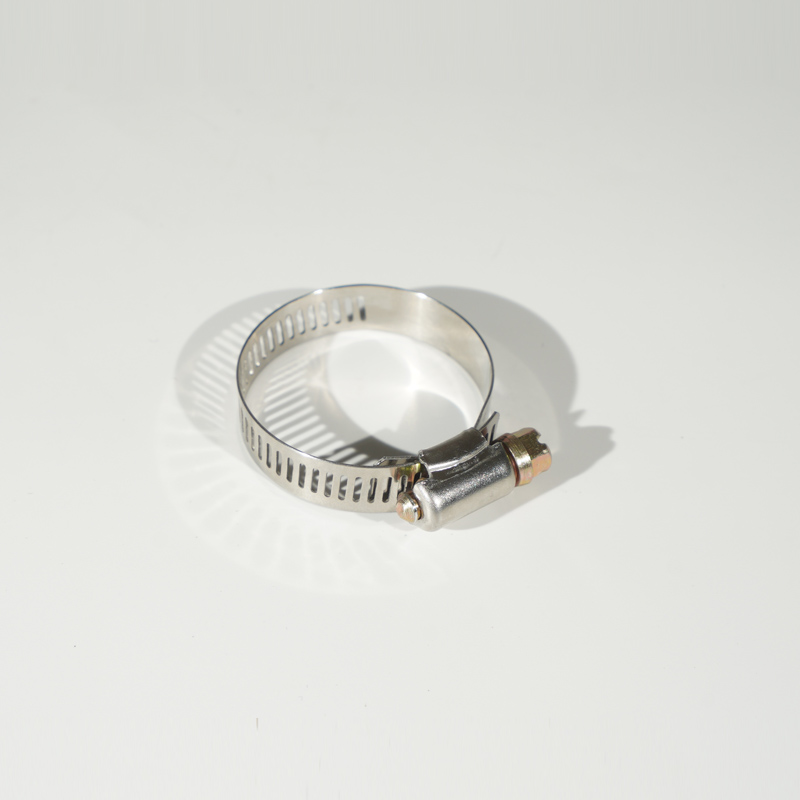
Customer Testimonial:
"We've been sourcing our stainless steel hose clamps from Puxing Clamp for over five years now, and the consistency in quality is unmatched. Their SS304 clamps have drastically reduced our maintenance issues in the automotive assembly line, especially for critical cooling system connections. The team's technical support is exceptional, always ready to assist with specific requirements. Truly a trustworthy partner." - Head of Procurement, Global Auto Parts Manufacturer.
Trustworthiness & Support: Our Commitment to You
Building trust is at the core of our business philosophy. At Puxing Clamp, we are committed to providing not only superior stainless steel hose clips but also unparalleled service and support throughout your procurement and application process. Our commitment is underpinned by robust guarantees and transparent operations, fostering long-term relationships with our clients.
Quality Assurance & Certifications:
Every Stainless steel 304 hose clamps from our facility undergoes stringent quality control procedures, adhering to international standards such as ISO 9001:2015. Our materials are traceable, and we provide material test certificates (MTCs) upon request, ensuring complete transparency regarding the quality and composition of our stainless steel. We conduct in-house and third-party testing to validate performance claims, including detailed salt spray tests (e.g., 200 hours minimum without red rust for SS304) and torque tests.
Warranty & After-Sales Support:
We stand behind the quality of our products with a comprehensive warranty against manufacturing defects and material failures under normal operating conditions. Our dedicated customer support team is available to address any queries, provide technical assistance, or help with product selection. We believe that our responsibility extends beyond the sale, ensuring your long-term satisfaction and successful application of our stainless steel hose clips.
Delivery & Logistics:
Understanding the critical nature of timely delivery, we maintain efficient production schedules and robust logistics partnerships. Standard orders typically have a lead time of 7-14 business days, while customized solutions may require 3-4 weeks for prototyping and production. We offer various shipping options to meet your urgency and budget requirements, ensuring your hose clamps arrive when and where you need them.
Environmental Responsibility:
We are committed to sustainable manufacturing practices, minimizing waste, optimizing energy consumption, and ensuring responsible sourcing of raw materials. Our operations are guided by ISO 14001 principles, reflecting our dedication to environmental stewardship.

Frequently Asked Questions (FAQ) about Stainless Steel Hose Clips
Q1: What is the primary difference between Stainless Steel 304 and 316 hose clamps?
A: Stainless Steel 316 contains molybdenum, which significantly enhances its resistance to pitting and crevice corrosion, especially in chloride-rich environments like saltwater or chemical processing. SS304 offers excellent general corrosion resistance but is less suitable for highly aggressive saline or acidic conditions. For most general-purpose applications, SS304 stainless steel hose clamps are perfectly adequate and cost-effective. For marine or harsh chemical exposure, SS316 is recommended.
Q2: How do I determine the correct size of a hose clamp for my application?
A: Measure the outer diameter (OD) of your hose with the fitting inserted. The ideal hose clamp should have a clamping range that encompasses this measurement. Always choose a clamp whose minimum diameter is slightly smaller than your hose's OD and whose maximum diameter is slightly larger, allowing for secure tightening. For example, a 2 inch hose clamp (50.8mm) typically has a clamping range like 40-60mm.
Q3: What are the common types of stainless steel hose clamps?
A: The most common types are:
- Worm Drive Clamps: Versatile, easy to install, and widely used for general purposes.
- T-Bolt Clamps: Offer higher clamping force and are suitable for heavy-duty, high-pressure, or high-vibration applications.
- Spring Clamps: Designed to compensate for thermal expansion and contraction, maintaining consistent pressure.
- Band Roll Clamps / Strapping: Used for custom large diameter applications, often cut from a continuous roll.
Q4: What is "torque specification" and why is it important for a stainless steel hose clip?
A: Torque specification refers to the recommended amount of rotational force to apply when tightening the clamp. Applying the correct torque is crucial because under-tightening can lead to leaks, while over-tightening can damage the hose, strip the screw, or deform the clamp itself. Reputable manufacturers provide these specifications, often measurable with a torque wrench, to ensure optimal sealing performance and extend the life of both the hose and the stainless steel hose clamp.
Q5: Can stainless steel hose clamps be reused?
A: Generally, most worm drive and T-bolt stainless steel hose clamps can be reused, provided they are not damaged (e.g., bent, stripped screw, deformed band) and have not experienced excessive corrosion or fatigue. However, for critical or high-pressure applications, it is often recommended to use new clamps to ensure maximum integrity and safety, especially if the old clamp shows any signs of wear or deformation.
Q6: What industry standards should a high-quality stainless steel hose clip meet?
A: Key standards include ISO 9001 (for the manufacturer's quality management system), SAE J1508 (performance standards for worm drive hose clamps), and ASTM standards for material composition (e.g., ASTM A240 for stainless steel). For specific applications, there might be additional industry-specific standards (e.g., FDA compliance for food-grade applications, or specific automotive OEM standards).
Q7: How does Puxing Clamp ensure the anti-corrosion properties of its Stainless steel 304 hose clamps?
A: We ensure superior anti-corrosion properties by using certified virgin Stainless Steel 304 material, rigorous material testing (including XRF for composition), precise manufacturing processes that avoid contamination, and a final passivation treatment. Additionally, regular salt spray testing (ASTM B117) of our finished products confirms their long-term resistance to environmental degradation, demonstrating excellent performance even after prolonged exposure to corrosive conditions.
References & Further Reading:
For more in-depth information on fastener technology and material science, consider exploring resources from reputable industry associations and academic journals:
- "Global Industrial Fasteners Market Size, Share & Trends Analysis Report" - Grand View Research. Available at: https://www.grandviewresearch.com/industry-analysis/industrial-fasteners-market (Please note: This is a placeholder link for a typical market research report source.)
- "Understanding Stainless Steel Grades for Fasteners" - Fastener Technology International Journal. Available via industry publications or relevant academic databases (e.g., ASM International, SAE International).
- "SAE J1508 - Hose Clamp Specifications" - Society of Automotive Engineers. Full standard details usually require membership or purchase: https://www.sae.org/standards/content/j1508_200908/
- "Corrosion Resistance of Stainless Steels" - NACE International (The Worldwide Corrosion Authority). Resources can be found on their official website: https://www.nace.org/
-
Large Adjustable Stainless Steel Hose Clamp - Hebei Pux Alloy
NewsAug.08,2025
-
Premium Stainless Steel Hose Clip | Secure & Rust-Proof Clamps
NewsAug.08,2025
-
Large Stainless Steel Adjustable American Type Hose Clamp - Hebei Pux Alloy Technology Co., Ltd.
NewsAug.07,2025
-
Large Stainless Steel Adjustable Hose Clamp-Hebei Pux Alloy Technology Co., Ltd|Corrosion Resistance,High Breaking Torque
NewsAug.07,2025
-
Large Stainless Steel Adjustable American Type Hose Clamp - Hebei Pux Alloy Technology Co., Ltd
NewsAug.07,2025
-
Large Stainless Steel Adjustable American Type Hose Clamp - Hebei Pux Alloy Technology Co., Ltd|Corrosion Resistance&Adjustable Design
NewsAug.07,2025

